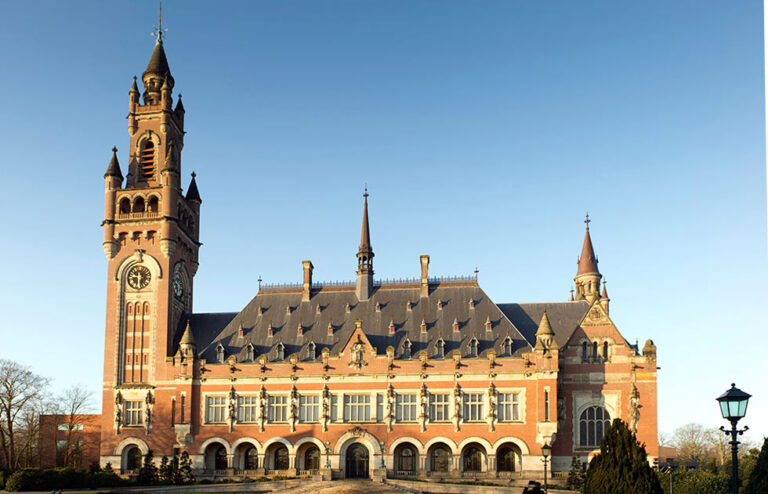
The Mawphlang Sacred Forest in eastern Meghalaya in India is perhaps the best preserved of the saree forests of the Khasi tribe in the state of Meghalaya. The place shows a space where rituals were held. It dates back to the 19th century. These sacred forest are considered so because rituals were held here, and no one is supposed to take anything out of the forest, otherwise, the belief is, a curse befalls on the person. Photo credit: Anushtup
Food habits of Indigenous People -3
The Khasi are a group of Indigenous Peoples that predominate in the eastern part of the hilly State of Meghalaya in northeastern India. Meghalaya is known to be the wettest region of India, and it is also recognised as a singular subtropical forest ecoregion that hosts a remarkable biodiversity.
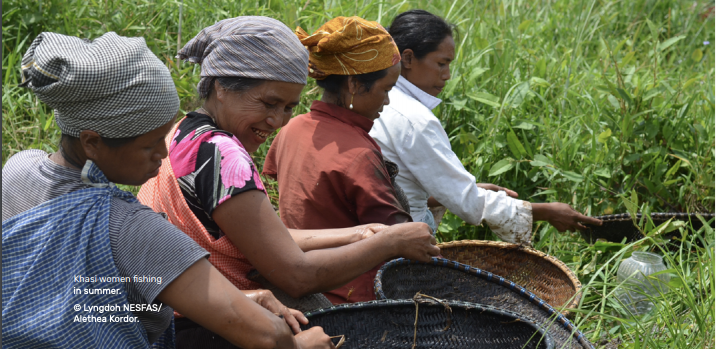
The village of Nongtraw, where the research took place, is inhabited solely by Khasi people. Nongtraw is a village located in the Khatarshnong-Laitkroh Community Development Block of East Khasi Hills District. The village is situated in the Cherrapunjee region, a highly dissected plateau along the southern margins of the Meghalaya Plateau in the northeast part of the country. Nongtraw lies along the mid-slope of a deep gorge. There is no road access to the village, so the only way to reach or leave the village is to climb 3 000 steps. Several streams are near the village, with the most important being Wahsohra, situated in the valley below. This region receives one of the highest rainfalls in the world, with average annual rainfall of more than 1 000 cm
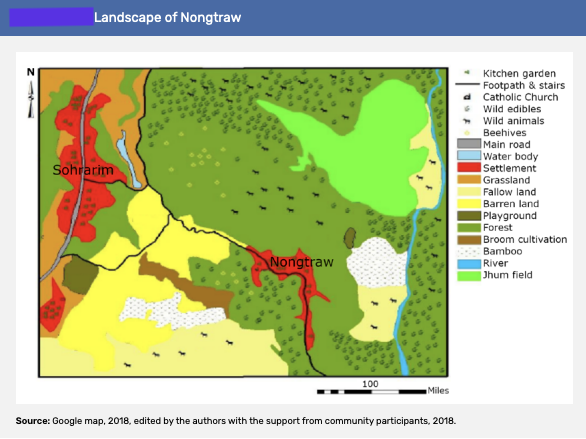
The food system of this matrilineal and Christian society relies on jhum (shifting cultivation), kper (home gardens), wild sourcing and the market. The jhum lands and the forests are communally managed. A high diversity of crops is produced (more than 60 were named), including a rich heritage of indigenous and traditional varieties. Access to local resources is vital for local food security and diet quality, since the landscape provides 50 to 60 percent of local diets and approximately 60 percent of income derives from crops and livestock.
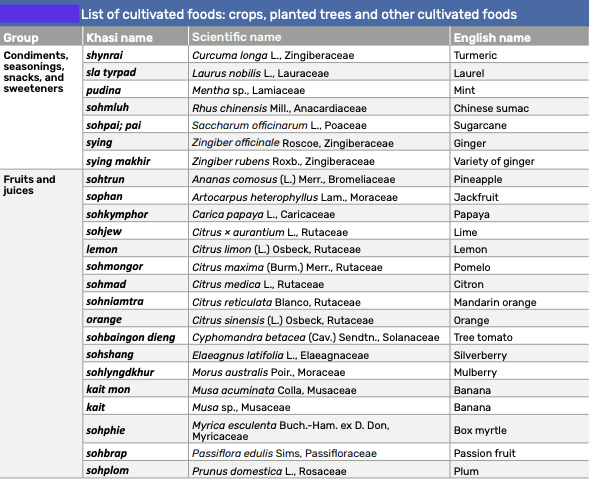
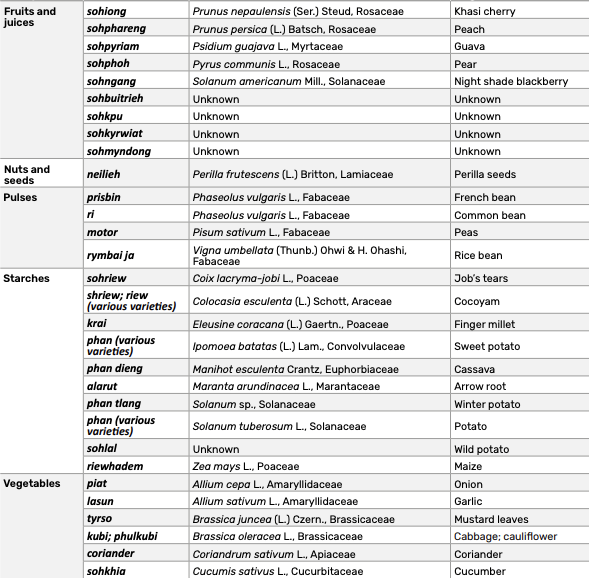

Food production from jhum and homestead gardens is supplemented by livestock rearing. All the households rear chickens. These chickens roam around the premises of the house during the daytime and sleep in the tree at night. Some of the eggs are consumed at home and the rest are sold at the market. In addition to chickens, they practise piggery, which is an important income source. Beekeeping is another important activity for some households. Big logs are used for keeping the beehives. Another method known as sympa allows the bees to make their hive on a standing tree in the forest. After the hive is completed, the beekeeper takes the beehive home for upkeep and harvesting. Beekeeping households can harvest around 40 litres of honey from two beehives during spring and autumn.
Also read: Food habits of Indigenous People: Arctic nomads Sámi’s ancestral food system faces global warming
Connected with the jhum are the forests from where there is jingbam na khlaw (foods from the forests). Wild fruits like sohlymwai, sohum (Syzygium cumini, Java plum), soh thylliang, sohliang, sohkhlot, soh khyrwiah, soh jrumshiah, soh-pong, sohshiah (Rubus ellipticus, Himalayan raspberry), sohmad (Citrus medica, citron), sohkhawiong (Rubus niveus, snowpeak raspberry), soh khaw-iong (Amomum aromaticum), sohpen (Eriosema himalaicum, Chinese bush carrot) and wild edibles like buckwheat, jali, jakhria, ka nub, pashor kait, tyrkhang iong (edible fern), jaïing and so on are important food items that people collect from the forest. These are found in greater numbers in summer as compared in winter. Honey is also collected from beehives from the forest. Wild edibles like jaïing and garlic chives are important products sold to the market by the community.
![]()

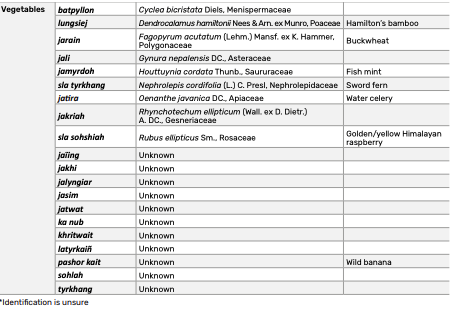
In addition to wild edibles, people collect many medicinal plants from the landscape. The important ones are bat tyrphin (Eucalyptus tereticornis Sm., Myrtaceae) – for curing toothache, food poisoning or stomach-ache; khnaing; bat rben (Bryophyllum pinnatum (Lam.) Oken) – used for curing wounds, fever, cold, burns and for making chutney; lapata (Vitex negundo L., Lamiaceae) – used for curing sprain, pangat for strain in the veins; mebteng – used for curing cuts; and bat baidoh (Sida rhombifolia L., Malvaceae) – for curing boils by crushing the leaves and placing them on the boil, which helps pull out the pus. Other common medicinal plants used by the people are sla pata, soh jalu and sla rynsi.
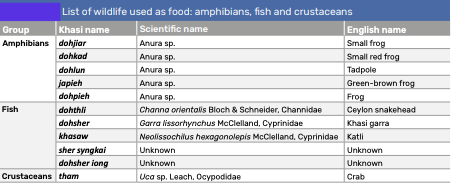
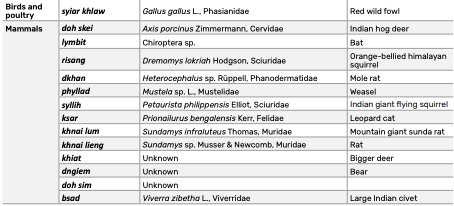
Meat from the wild is also included under jingbam na khlaw and has always been an important source of food for the community. Presently, the community occasionally gets meat from the wild. People trap animals for eating like phyllad (Mustela sp., weasel), dkhan (Heterocephalus sp., mole rat), khnai lum (Sundamys infraluteus, Mountain giant sunda rat), khnai lieng (Sundamys sp., rat), risang (Dremomys lokriah, orange-bellied Himalayan squirrel), syllih (Petaurista philippensis, Indian giant flying squirrel), ksar (Prionailurus bengalensis, leopard cat), syiar khlaw (Gallus gallus, red wild fowl), bsad (Viverra zibetha, large Indian civet) and lymbit (Chiroptera sp., bats). Men and especially children go to the forest to hunt and trap mole rats in the winter. Fishing Some of the people from the community catch fish from nearby streams for household consumption.
In spite of its remoteness, the village of Nongtraw for a long time has taken part in the weekly market in the adjoining villages. These markets allow for important social interactions and are places where local produce, goods and services are bartered and traded.

The market has become an important source of the community’s dietary needs, currently providing approximately 40 to 50 percent of foods consumed. Items like dal (Lens culinaris, lentil), egg, rice and potato are bought throughout the year from the market. Other food items bought regularly include beef, pork, radish (Raphanus raphanistrum), turnip (Brassica rapa), carrot (Daucus carota), beetroot (Beta vulgaris), grams, sugar, salt, mango (Mangifera indica), apple (Malus sp.), sohlang (Viburnum foetidum), gooseberry (Ribes uva-crispa) and grapes (Vitis vinifera).
The Khasi have been traditionally open to contacts and marriage with other groups. This interdependent and open socioeconomic approach is one of the reasons why the Nongtraw inhabitants obtain an important share of their diet from the market.
In total, the food system of the Khasi people is based on 150 species and varieties of plants and animals used for food. In addition, there are at least 17 prominent species used for construction and materials, and medicinal purposes. People are of the opinion that local diets are adequate for fulfilling their nutritional needs but they are not completely immune to food insecurity, which has been experienced as a result of extreme weather conditions in recent years.
The food-producing activities in Nongtraw are agriculture, livestock rearing, some amount of fishing, and collection of wild edibles from the forest. In the local perception, food is divided on the basis of where it is sourced, which means jingbam na lyngkha (from the jhum field), jingbam na kper (homestead garden), jingbam na khlaw (forest) or jingbam na wah (rivers).
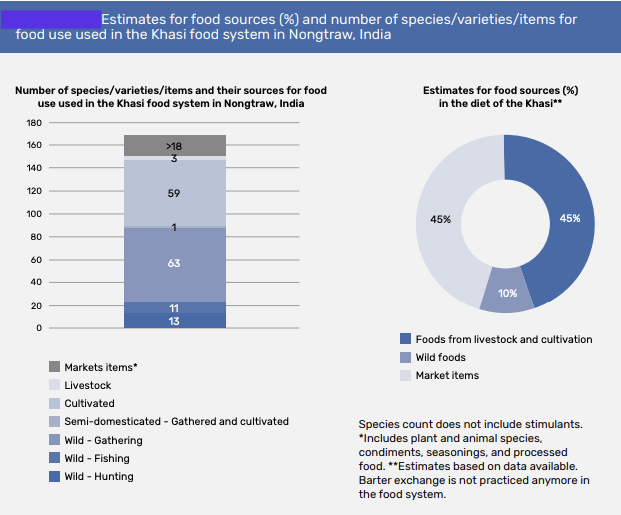
Crops grown in the jhum field include tubers like yam (Colocasia esculenta), potato (Solanum tuberosum), sweet potato (Ipomoea batatas), cassava (Manihot esculenta), other tubers like phan sawhoin, phan jata and phan shriew (Solanum sp.), and sohlah; vegetables such as: jaïing, jarain (Fagopyrum acutatum, buckwheat), jali (Gynura nepalensis), sla phan karo (Ipomoea sp.), jyllang (Allium tuberosum, garlic chives), mustard leaves (Brassica juncea), cucumber (Cucumis sativus), etc. Fruit trees are also found in the jhum fields with the important fruits being sohbrap (passion fruits, Passiflora edulis), soh pdok (Solanum myriacanthum), papaya (Carica papaya), sohtrun (Ananas comosus, pineapple), etc. The other important crops cultivated in the jhum fields are maize (Zea mays), millets (Eleusine coracana), Job’s tears (Coix lacryma-jobi), a small amount of sugar cane (Saccharum officinarum) and kait khar (Musa sp., banana variety), amongst others. Jingbam na kper or crops grown in kitchen gardens is another important category of crops identified by the community during the thematic discussions. Here, crops are mostly fruits like banana, sohiong (Prunus nepaulensis, Khasi cherry), sohshang (Elaeagnus latifolia, silverberry), sohpyriam (Psidium guajava, guava), sohlyngdkhur (Morus australis, mulberry), sohphie (Myrica sp., box myrtle), passion fruit and sophan (Artocarpus heterophyllus, jack fruit). Other important crops grown in the kitchen garden are, for instance, sugar cane, bay leaf (Laurus nobilis) and mustard leaves.
The resilience of the Khasi food system has gotten stronger over time and this positive observation seems to stem from the strength of the self governance and customary institutions in the community.
Major changes occurring in recent years
- India’s overall public distribution system has changed the local subsistence system;
- rice has supplanted local staples (millet and pulses);
- reduced presence of wild foods in the diet;
- increased cash income economy;
- loss of food sharing and barter practices;
- emergence of cash crop production (broom grass). Trends expected by the Khasi in future years
- no expected changes by the Khasi, who trust the resilience of their food system supported by the solid self-governance of their community.
(Source of the article, tables and photo: Indigenous Peoples’ food systems: Insights on sustainability and resilience from the front line of climate change (Published by the Food and Agriculture Organization of the United Nations)
– global bihari bureau


